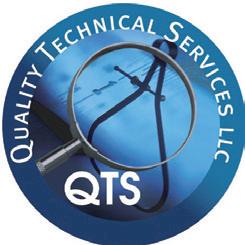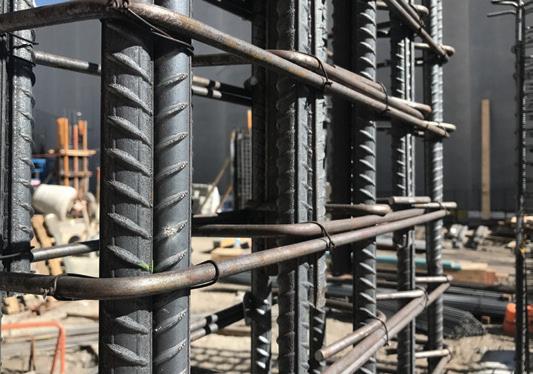
8 minute read
ASSET MANAGEMENT
ADAPTING ASSET MANAGEMENT
TO NEW WAYS OF LIFE
Advertisement
by Kim Ho, Journalist, Infrastructure magazine
As governments continue to work to get the COVID-19 crisis under control, critical assets must still be managed, monitored and maintained. Tammy Falconer, Director at KPMG Australia, argues that while the pandemic has confronted asset managers with once-in-a-career challenges, it also presents a unique opportunity for them to lead their teams, their sectors and the Australian community through this period of uncertainty.
The COVID-19 pandemic has transformed the world – impacting the ways we live, work, commute and communicate, and presenting major health risks and economic challenges. As much of Australia’s workforce took to working remotely, usage patterns for water, wastewater, electricity, internet and transport shifted in dramatic ways.
Speaking at the Asset Management for Critical Infrastructure Virtual Conference in May, Ms Falconer broke down some key findings from KPMG’s research and outlined the ways in which asset managers can continue working efficiently, manage maintenance backlog and – most importantly – turn disaster into opportunity.
A MARATHON, NOT A SPRINT
Spending the first part of her career in Darwin, Ms Falconer is no stranger to disaster management. Every year, she had to prepare for cyclone season, reviewing plans, testing disaster recovery systems, and ensuring a fast, coordinated response when the worst hit.
But a pandemic is different – not restricted to days or weeks, it requires a long-term approach to disaster mitigation. Asset managers must go through an elongated process: first reacting to the crisis, planning for ongoing operations, before hopefully returning to business as usual.
KPMG’s research into the challenges of COVID-19 in America revealed that US water, gas and electricity utilities typically planned in weeks for severe weather events, so they failed to anticipate the first-of-a-kind response of prolonged social distancing.
The research also yielded the following findings: ♦ Working remotely was a delicate balance for utilities, and while 50 per cent of corporate functions could be performed remotely, only 10-25 per cent of transmission and distribution functions were being performed remotely ♦ Utilities had not considered extreme conflated risks of two or more events occurring at the same time in their risk management plans ♦ Employee wellness was a near-term focus that may result in long-term changes including an increased emphasis on hygiene and personal care procedures ♦ The scale of the pandemic exceeded typical utility business continuity plans. The magnitude of potential lack of employee resources combined with technology restrictions to enable off-site working was not factored into plans. ♦ The expected shift in demand and workforce may result in regulatory changes with reduced revenue forecasts impacting financial plans for future regulatory decisions FOCUSING ON FOUR HORIZONS
Even with the desire to update an organisation’s approach to disaster management, it can be difficult to determine where to focus energy and resources – especially with such an enormous, ever-changing situation and no clear end in sight.
To assist asset management professionals through this disruption, Ms Falconer proposed turning attention to four horizons: 1. Reaction: focusing on crisis management, essential supply and public safety 2. Resilience: working to secure the supply chain and focusing on essential maintenance and projects 3. Recovery: implementing sustainable set work practices with re-prioritised programs of work 4. New reality: planning for the transition into a new normal, and adapting to new expectations from staff, customers and stakeholders
USING CRITICAL INFRASTRUCTURE TO DRIVE ECONOMIC RECOVERY
Governments across Australia are recognising the key role that maintenance and capital investment can have in stimulating the economy, and fast-tracking smaller, ‘shovel-ready’ projects has become a key approach to the economic recovery. In this way, asset managers can play a critical part in getting Australia back on track.
“We all have a role to play in this crisis; but as asset managers of critical infrastructure, you can play an even bigger part, helping to address the economic impact of this crisis,” Ms Falconer said.
“You can make a difference to your community, your supply chain, and ensure your organisation is in the best position at the end of this crisis to continue to provide the valuable services to your customers.”
MAINTENANCE AND RISK
Asset managers should first focus on determining if the risk profile of asset maintenance has changed due to the pandemic.
Ms Falconer said organisations should ask themselves the following questions: ♦ How have our customers’ asset utilisation patterns changed? ♦ Has the risk profile of our maintenance task changed due to social distancing requirements? ♦ How can we keep our staff, contractors and the community safe? ♦ Has our supply chain risk changed? ♦ Do we have access to the services, tools and materials that we need to perform maintenance?
ADDRESSING YOUR MAINTENANCE BACKLOG
KPMG has heard from clients that a significant volume of noncritical maintenance was deferred due to pandemic restrictions.
“But how long can that last?” Ms Falconer asked. “Critical infrastructure needs to continue to reliably provide services to the community – we can’t indefinitely defer maintenance.”
Organisations must assess what risk this backlog might pose for assets and services, but also what opportunities it might provide to work differently.
Service-level risks may have financial and environmental impacts, but risks could be as significant as increased bushfire danger for electricity providers.
“Coupled with positive economic impact achieved through continuing work, there’s a compelling argument to continue establishing interim maintenance practices quickly.”
When addressing maintenance backlog, Ms Falconer suggested starting by analysing the impact of asset failures on service standards; establishing asset condition limits based on the organisation's tolerance for risk; identifying potential failure events; and using this information to prioritise the backlog.
Asset managers should review and adjust maintenance job plans to ensure social distancing measures are in place.
Technological advances may help accomplish more work with less physical contact. Ms Falconer prompted organisations to consider how drones, augmented reality, autonomous vehicles or robots could help maintain social distancing requirements.
Conducting maintenance also provides the opportunity to build trust with customers by optimising scheduling to take into account changes in asset utilisation patterns, communicating outages proactively, and noting the actions being taken to minimise impacts on them.
“Yes, this is a more complex environment we’re operating in, but could it be an opportunity for your organisation to really understand your assets and adopt new ways of working to benefit now, but also make your organisation more resilient in the future?” Ms Falconer said. MANAGING SUPPLY CHAINS
This complex situation has placed financial pressures on supply chains, especially when relying on overseas suppliers for parts.
Ms Falconer urged asset managers to be responsive to the pressures, and use this time to cultivate a deeper understanding of their strategic operations and supply chain. This will help develop more collaborative and resilient relationships with critical suppliers – or identify where sourcing alternative suppliers is required.
One example solution was to follow the Victorian Government’s lead in fast-tracking supplier invoice payments, helping suppliers remain viable.
Clients may also be concerned with commercial and legal implications of COVID-19, fearing suppliers and contractors making claims against them due to delays.
“Developing a consistent strategy to manage these issues ahead of time will enable you to work proactively, rather than enter into multiple disputes with suppliers which will inevitably impact project delivery,” Ms Falconer said.
Staying on the front foot with stakeholder management and communication is also vital to keep government, suppliers, teams, customers and the public informed and reassured.
Organisations’ remobilisation efforts should involve developing a transition plan, working closely with their supply chain to address any constraints, and ensuring they have any specialist skill sets that were previously sourced overseas.
Ms Falconer said an ‘all in this together’ approach for capital projects was vital to retain collaborative relationships with all stakeholders.

MAINTAINING A PRODUCTIVE WORKFORCE
Amidst this disruption, Ms Falconer said maintaining motivation and productivity was vital to efficient service delivery.
Team leaders must calibrate employees’ expectations as the situation evolves; maintain enough visibility to evaluate performance; implement strategies to channel motivation; leverage the right technology to support remote work arrangements; check in on individuals’ mental well-being; and ensure their capability is aligned with capacity.

A ONCE-IN-A-CAREER CHALLENGE – BUT ALSO AN OPPORTUNITY
Ms Falconer knows the stakes of this crisis. If critical infrastructure organisations fail to take a risk-based approach to asset maintenance, delay delivery of key projects and neglect the front end of their value chains, this once-in-acareer challenge will only grow in scale.
“As asset management professionals, we know that effective asset management is a long-term game. If we don’t focus on the upstream parts of our asset value chain, we'll see productivity issues extend well past the end of this pandemic.
“Projects will not be planned, procurement will be delayed, and the risk associated with maintenance backlog will divert resources to unplanned work and away from planned work.”
Despite the daunting path ahead, Ms Falconer is convinced that because maintenance and capital investment is so central to Australia’s economic recovery, the onus is on asset management professionals to lead Australia through the crisis.
“The critical infrastructure sector has the unique opportunity to stand up and provide leadership – the leadership your teams need to keep your teams safe, well and productive; the leadership your organisation needs to remain sustainable; but also the leadership that your country needs to minimise the economic impact of the pandemic on fellow Australians,” she said.
“This isn’t going to be easy, but it could be one of the biggest contributions that you will make in your career.”
Quality Verification of Railway Locomotives, Wagons, Steel Rails & Track Turn-Outs


Pre-award audits of manufacturers, subcontractors and suppliers Experienced, certified and qualified inspectors Verification of manufacturing and testing in accordance with AS standards Surveillance inspections throughout the entire manufacturing process Individual inspection and test of completed equipment Pre-delivery and ship loading inspections ISO 9001-2015 QMS certified company
Quality Technical Services LLC
Shanghai Operations Office Contact: Frederik Ford Mobile: +86-13501790361










